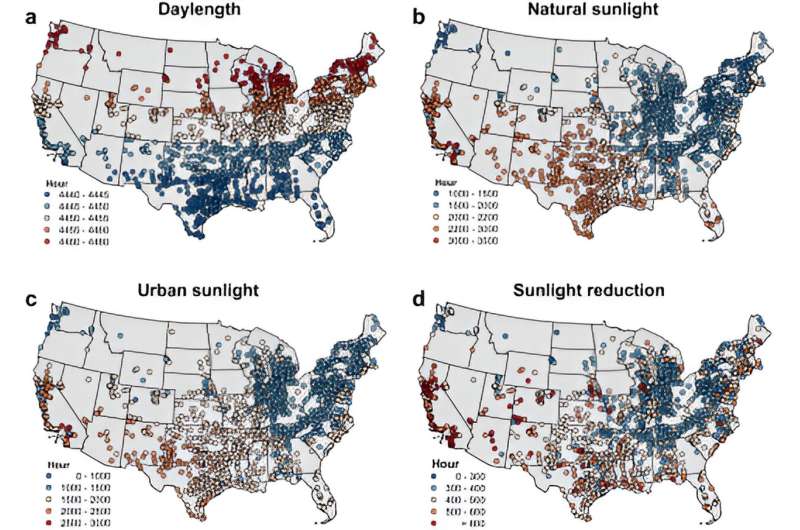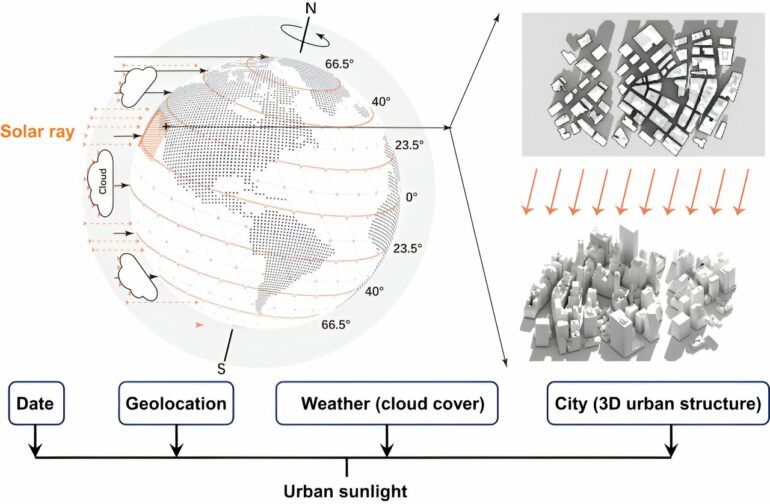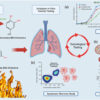Sunlight plays a crucial role in public health, affecting vitamin D synthesis and psychological well-being. Inadequate exposure to sunlight is associated with various adverse health outcomes, such as cardiovascular diseases, metabolic syndrome, depression and mental disorders.
The ideal sunlight, or baseline, represents the maximum amount of sunlight a region would receive annually in the absence of cloud cover or urban structures, approximately 4,460 hours. Urban development, especially skyscrapers, can block natural sunlight, reducing exposure by up to 90% in high-rise cities like Hong Kong.
This lack of sunlight contributes to health issues such as vitamin D deficiency and myopia, particularly among children and the elderly. The rapid rise in tall buildings since the 1970s has exacerbated the problem, highlighting the need for urban planning that ensures adequate sunlight for residents.
Recently, researchers from HKU have developed a framework to assess sunlight duration in cities, revealing a substantial reduction in available sunlight due to cloud cover and three-dimensional urban structures. The findings have been published in Nature Cities, underscoring the imperative for integrated approaches to urban planning that emphasize sufficient access to sunlight.
Existing studies often overlook the details of how 3D urban structures and cloud cover together affect sunlight availability.
The research team synthesized a suite of remote-sensing data and process-based models, related to urban built-up areas, cloud observations, urban structure parameters and climatic conditions—representing a “digital twin” of the urban environments—to evaluate sunlight dynamics across 1,353 cities in the United States for the year 2020.
Applying this framework to 1,353 U.S. cities, the findings reveal a significant decrease of 2,896 h (121 days) in available sunlight for 2020, with cloud cover accounting for 2,448 h (102 days) and urban structures contributing to a 448-h (19-day) loss.

Annual Sunlight Maps for 1,353 U.S. Cities in 2020: a) Day Length: Sunlight duration from sunrise to sunset. b) Natural Sunlight: Actual sunlight owing to cloud cover. c) Urban Sunlight: Sunlight over built-up areas. d) Sunlight Reduction in Built-Up Areas: Difference between natural and urban sunlight due to 3D urban structures. © Nature Cities (2024). DOI: 10.1038/s44284-024-00120-x
Nationwide findings reveal that cloud cover and urban structures significantly reduce annual sunlight hours. Cloud covers alone account for a 55% reduction in sunlight, translating to 102 days of lost sunlight annually. Urban structures contribute an additional decrease of approximately 19 days annually.
Notably, the effects of cloud cover are more pronounced in northeastern regions (such as Maine and New York) and northwestern regions (such as Washington), where annual sunlight hours decrease from 4,460 to 1,500. Furthermore, urban shading impacts show distinct geographic variations, with more severe patterns in coastal cities.
Professor Bin Chen, the project’s principal investigator and Assistant Professor of Division of Landscape Architecture at HKU said, “This study grows out of our earlier research published in 2023 in Nature, about optimizing urban shade using digital twins, and aiming to investigate the interplay between nature and three-dimensional urban structures that limit sunlight availability.”
Professor Chen emphasized two important contributions from this study and said, “The developed conceptual model enables us to account for various factors, including latitude, cloud cover, seasonal variations and urban structures to the sunlight duration.
“This is crucial for capturing the complex interplay between geographic, climatic and structural elements that affect sunlight exposure in densely built-up urban areas. Another key insight is that the cumulative impact of these factors leads to a total annual reduction of 2,896 sunlight hours, equivalent to 121 days.”
“With the observed increasing trends in cloud cover and urbanization, sunlight loss is likely to worsen.” Professor Chen remarked that the study highlights the pressing need for interdisciplinary urban planning strategies that prioritize adequate access to natural sunlight.
“Rapid urbanization and the increase in tall buildings have profound implications for both energy management and public health. The sunlight loss could exacerbate energy demands and increase carbon emissions, particularly in colder regions and during colder seasons. We need localized regulations to ensure fair access to sunlight in high-density areas,” said Professor Chen Lin, Chair Professor of Finance, Associate Vice-President at HKU.
More information:
Shengbiao Wu et al, The interplay of cloud cover and 3D urban structures reduces human access to sunlight, Nature Cities (2024). DOI: 10.1038/s44284-024-00120-x
Provided by
The University of Hong Kong
Citation:
Cloud cover and urban structures drastically reduce sunlight in cities (2024, September 25)



